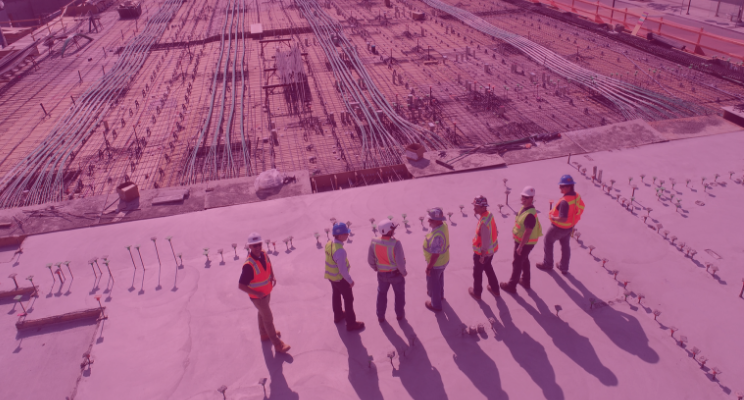How to solve the skills shortage in construction: innovation, automation and point clouds

Construction is a major sector within the UK economy, generating 6.7% of GDP (almost £90 billion annually) and employing around three million people; about 10% of UK employment.
The skills shortage in construction has been a concern in the infrastructure sector for many years. The Institution of Civil Engineers 2018 Professional Skills review identified a shortage of civil engineers as well as lack of particular skills that were in high demand, such as coding and offsite construction.
There are around 9,000 college leavers, graduates and apprentices joining the construction profession every year. But this is likely not enough. 80% of civil engineers identify the skills shortage as the main challenge for the future of the industry. With high profile projects such as developing nuclear and alternative energy, Crossrail, national infrastructure and HS2, the demand for engineering and construction professionals is only growing.
A changing tied with a bright future
The construction industry has traditionally been regarded as slow in turning to new technology to bolster productivity. The good news is that there are great examples of creative technological adoption that are starting to emerge.
The next generation of civil engineers appear to have more faith in the power of technology than their senior leaders. Nearly 60% of younger civil engineers believe technology is a key solution to the skills problem, only 23% of the old generation agree. It is not surprising that a fifth of all infrastructure professionals believe their business is resistant to change.
More (56%) junior staff also thought the industry reluctant to work collaboratively, compared with 37% of senior leadership. However, 84% recognise that changing working practices is not going to be easy.
Cost (27%) and company culture (22%) were given as the greatest barriers to the industry adopting new technology and working practices.
Examples of transformation
Some companies are actively looking to recruit digital natives who, aligned with their digital knowledge, can develop good engineering practice, construction techniques, and the skills of how to manage both projects and clients. These beacons of excellence are spreading their expertise across to other organisations in their supply chain with change being driven through the way work is awarded.
Digital technology is the catalyst to maximise the resources we have, to meet our growing infrastructure and industry demands. Through automation, collaboration and visualisation, digital adoption is starting to provide real evidence of faster and better outcomes; and encouraging creativity and innovation between designer, contractor and operator.
Fortunately, there has never been a better time than now to embrace this technology-driven change. A confluence of several technological trends have made digital and automation tools far more comprehensive and robust than even fifteen years ago.
A new way to build: digital models and digital construction
The big change in construction has been the maturation of scanning, modelling and automation technologies. Together, these technological toolsets support that ability to map 3D space, model project, prefabricate parts, and rapidly deploy quality assured outcomes with fewer people and in less than was imaginable a decade ago.
Point clouds: the bedrock of digital visibility
Point clouds are a spatial storage technology. Commonly generated using 3D laser scanners and LiDAR (light detection and ranging) technology and techniques, these scans are stitched together to create a complete image of a scene.
Allowing for the rapid capture of highly-accurate 3D data, point cloud are a central piece to creating 3D models, informing automated construction technology and quality checking the output of those same tools and techniques.
Point clouds have been part of the commercial construction industry since the 1990s. What has recently changed are the algorithms responsible for stitching together the multiple scans that create a finished point cloud.
Multi-stage, vector-based processing has reduced the amount of time it takes to go from scanning to a complete point cloud by 40%-80%, while increasing automation — slashing a painstaking and costs processes in producing a point cloud. This has liberated engineers to use point cloud scanning technology in a far wider range of circumstances, allowing all of these other technologies and techniques on this list to be deployed more easily and effectively.
Automated and prefabricated construction
Armed with point cloud models and laser scan based quality assurance, construction firms and contractors are taking a much closer look at the advantages of prefabrication and 3D printing. Offsite fabrication allows components or even whole buildings to be assembled away from the site. Robotics and automation are also beginning to supplement human workers. New developments in virtual and augmented reality technology allowing users to visualise complete virtual buildings in-situ, even while the project is underway.
Evolving technology
Companies are adopting various project management software platforms, which are becoming indispensable tools. 3D modelling has been visible within the tall buildings sector for some time, now the industry is embracing this and a whole range of new digital tools across every aspect. Underpinning these trends in virtual reality, automated construction, 3D printing and augmented reality is the need to represent the real environment in digital terms – what is known as creating a digital twin. One development which underpins this move from physical to digital, and back again, is the use of laser scanning and point cloud creation.
New management techniques
As point cloud data becomes a more widespread currency in automated workflow, we move closer to creating digital twins — from individual buildings to whole cities. Many initiatives are now underway to exploit real-life data to guide construction projects. Building Information Modelling (BIM, which has already been around for ten years, is leading the charge, and acting as a catalyst to create new virtual design and construction management processes, more geared for the 21st century.
Technology can’t solve our issues alone: culture is the key
Driven by advances (such as point clouds, BIM and automation), and in light of the skills shortage, construction firms are moving towards more agile workflow processes. Management, planning and site software, tied with mobile apps are making life simpler, improving processes and streamlining tasks. Reality capture is already demonstrating the potential to bring far-reaching elements of the value chain together and deliver real cost and time savings.
Technology allows fewer engineers and construction workers to take on larger projects with confidence. Automation, digital modelling and new ways of building are all critical addressing the skill set, and are an evolving technology base that has a bright potential within the construction industry.
However, technology alone can’t solve the skills shortage. We will have to constantly change the way we think and work to unlock the productivity potential of digital construction. The onus is on everyone involved to keep learning and challenging ourselves and each other.
It will take time. This is a large and important industry with a huge supply chain, and deeply embedded behaviours. But it will change, the skills shortage means it must.
Tags: construction
.jpg?width=3080&name=Blog_CTAs_New%20(1).jpg)

